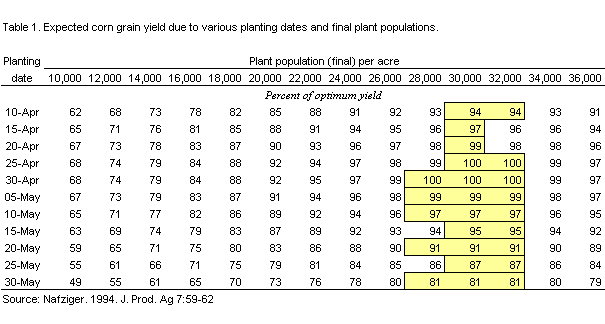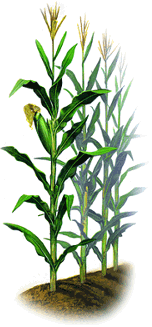

![]() mong the many questions raised by Indiana & Ohio
corn growers as the rain-delayed planting season continues is whether delayed
planting should influence their seeding rate decisions for corn. As might be
expected, several factors need to be considered.
mong the many questions raised by Indiana & Ohio
corn growers as the rain-delayed planting season continues is whether delayed
planting should influence their seeding rate decisions for corn. As might be
expected, several factors need to be considered.
First of all, what defines ‘optimum’ final population for corn in our two states? For most of our production areas, the answer is a range of final stands from 28-32,000 plants per acre (Nafziger, 1994; Paszkiewicz & Butzen, 2001). Some exceptions exist for that rule of thumb. Marginally yielding soils (consistently less than about 120 bu/ac) probably respond best to final populations nearer to 24,000 plants per acre, while exceptionally high yielding environments (greater than 180 bu/ac) probably respond better at final stands approaching 34-36,000 plants per acre (Paszkiewicz & Butzen, 2001).
So, the first step for Indiana & Ohio corn growers when considering late planting consequences for seeding rates is to determine whether they are normally seeding at rates that will achieve the optimum final stands for the productivity level of each field in their operation. Typically, seeding rates are calculated based on an assumed 90 percent success of germination, emergence, and seedling survival. For example, to achieve a targeted final stand of 30,000 plants per acre at harvest, one would seed at a rate equal to about 33,300 seeds per acre (30,000 divided by 0.90).
If you are already following these seeding rate guidelines, then delayed planting should not alter those seeding rates because the range of optimum final plant populations is similar for early and late planted corn. Table 1 illustrates the similarity of yield responses to population for corn planted at varying planting dates in research conducted by the Univ. of Illinois. Regardless of planting date, optimum grain yield occurs for most situations within a similar range of final populations.

That said, it is important to recognize that no two farming situations are the same. Caveats and exceptions abound and should be considered when making a decision about seeding rates for late plantings.
Scenario #1: Soil temperatures for corn planted in late May or early June will be quite warm relative to that of usual late April or early May plantings. Couple that with the likely ample availability of soil moisture and the odds are that germination and emergence success will be greater than normal. Consequently, you may elect to reduce your seeding rate accordingly. Instead of planting 33,300 seeds to achieve 30,000 plants (90% success rate), you may elect to plant only 30,600 seeds per acre (98% success rate).
Scenario #2: If you eventually
switch from your normal hybrid maturity to a much earlier maturity hybrid, you
may actually want to increase your seeding rates by several thousand. Hybrid
maturities (Nielsen, 2002![]() ) of 100-day CRM or
less often respond better to higher final stands than later maturity hybrids.
Instead of aiming for final stands from 28-30,000 plants per acre, these very
short season hybrids may respond better to final stands of 34-36,000 plants per
acre (Paszkiewicz & Butzen, 2001). Consult your seed company
sales representative for specific hybrid planting rate information.
) of 100-day CRM or
less often respond better to higher final stands than later maturity hybrids.
Instead of aiming for final stands from 28-30,000 plants per acre, these very
short season hybrids may respond better to final stands of 34-36,000 plants per
acre (Paszkiewicz & Butzen, 2001). Consult your seed company
sales representative for specific hybrid planting rate information.
 Scenario #3: Later planted
corn will be taller than early planted corn because its stalk elongation phase
occurs during a time period that is relatively warmer (later in the season)
than when early planted corn goes through the same phase. Not only will the
plants themselves be taller, but ear placement will also be higher (same stalk
node, but higher off the ground due to stalk elongation).
Scenario #3: Later planted
corn will be taller than early planted corn because its stalk elongation phase
occurs during a time period that is relatively warmer (later in the season)
than when early planted corn goes through the same phase. Not only will the
plants themselves be taller, but ear placement will also be higher (same stalk
node, but higher off the ground due to stalk elongation).
Consequently, a hybrid that is on the tall side to begin with will be even taller and its ears placed higher when planted unusually late. Such a combination of a tall hybrid and delayed planting will result in an increased risk of stalk lodging this fall if strong windstorms occur before harvest (anyone remember last October?).
One strategy to minimize this risk is to seed such a hybrid at rates closer to the low end of the optimum range in order to minimize the plant-to-plant competition that can cause etiolation (elongation under shade conditions) and thinner diameter stalks. Another strategy is to simply switch to a physically shorter hybrid.
Scenario #4: Later planting of corn, in and of itself, does not increase the risk of stalk rot development later in the season. However, taller, high-eared, late-planted corn will be more susceptible to the stalk lodging consequences of stalk rot IF stalk rot develops.
One of the primary factors that contributes to stalk rot development is severe stress (heat, dry soils, disease, hail, insects, cloudy weather, soil compaction) occurring early in the grain filling period that severely limits photosynthesis. The timing of that stress relative to grain filling is the critical determinant to whether stalk rots develop in corn of any planting date (anyone remember two years ago?). Planting strategies to minimize this risk would be similar to those of Scenario #3 above, as well as to avoid wet fieldwork (compaction) yet this spring.
Scenario #5: There will undoubtedly be a few fields tilled and planted on the wet side once field conditions get even close to being suitable for field work over the next few weeks. One consequence of doing so is a cloddy seedbed that does NOT promote good seed-to-soil contact for rapid and uniform germination.
IF the weather should suddenly switch from frequent rains to total
dryness after such fields were worked and planted, germination would be
extremely variable, if not disappointing (anyone remember 1991?). Along with
the cloddy seedbed preparation, tilling and planting wet fields creates various
forms of soil compaction (Vyn, 2002![]() ) that are not
conducive for successful root development.
) that are not
conducive for successful root development.
IF you are forced into this wet fieldwork scenario, you may want to increase your seeding rate beyond what you normally use, in anticipation of unsuccessful stand establishment. Similarly, IF you decide to forgo some tillage in fields where seedbed conditions are marginal (characterized by a cloddy surface, ruts, uneven residue distribution) and plant no-till, you may want to increase seeding rates to compensate for the higher probability of greater seedling mortality.
 For other
information about corn, take a look at the Corn Growers Guidebook on the World
Wide Web at http://www.kingcorn.org
For other
information about corn, take a look at the Corn Growers Guidebook on the World
Wide Web at http://www.kingcorn.org